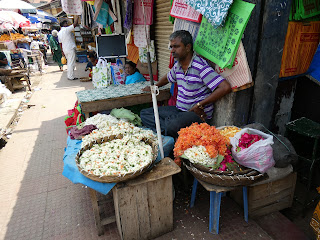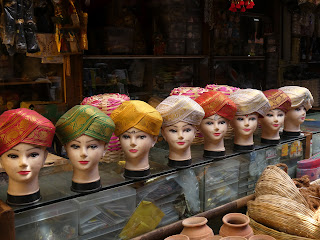We got to Mysuru just before the heavens opened again. Late afternoon/early evening thunderstorms were definitely the norm. It did create some very interesting sunsets though!
We were advised against breakfast in the hotel and instead Sanna took us for breakfast at a proper local place. Pancakes of various sizes and shapes, with spicy accompaniments is the norm in this area of India, and while having spicy things for breakfast is taking some getting used to, it was very tasty.
A short drive took us to the top of the Chamundi hills and the Chamundeshwari Temple. Mysuru is named after a demon that used to rule there, Mashashura. The wife of Shiva (the destroyer of evil), incarnated as Chamundeshwari and came to destroy the demon. This temple was dedicated to her and is a place of pilgrimage, particularly for women. We were there during the school holidays and there were quite a number of pilgrims there queuing to get into the temple. Coconuts were available and these are ritually smashed.
On the way back down the hill we stopped to see the view over the city and saw huge numbers of kites (Black and Brahminy) enjoying the thermals.
We also stopped to see the massive statue of Nandi the Bull, vehicle/messenger of Shiva. This statue is carved from a single outcropping of granite. It was recently cleaned and looks as fresh as the day it was finished!
For an unknown reason there was a tiger near the statue of Nandi, trying somewhat unsuccessfully to go unnoticed.
Next up was the Palace of Mysore, the second most visited place in India (after the Taj Mahal). It's an impressive building with a mixture of Hindu, Mughal, Rajput and Gothic styles, constructed around 1900. Some parts are still lived in by the old royal family. Many wall paintings of the annual procession that is held in the city. The palace also boasts impressive items from all over, chandeliers from France, mirrors from Belgium, tiles from England, stained glass from Glasgow and many electric fans from China.
The palace was also decorated with thousands of light bulbs to commemorate Mysore becoming the first city to be powered by hydro-electric. There are nightly light and sound shows, but unfortunately the evening thunderstorms rained off the shows while we were there.
Also, a 3 Striped/Indian Palm Squirrel and Red Naped/Indian Ibis.
Lastly for the day we went to the local market and had a good look around at the incense, flowers, fruit garlands and domestic hardware available there.
The Uber I took home that evening seemed to use his horn instead of his indicators, accelerator, brake and even in some cases, steering. It was quite the experience.
Next morning, before heading for the East coast, I took a tuktuk out to the temple at Somanathpur. It was built in 1258 but later damaged and vandalised by muslims during the war between Muslim Sultanates and Hindu kingdoms in the area. As the statues there have all been damaged, many with their noses removed, the temple is no-longer used for worship, and is instead now just a museum.
The 45 minute tuktuk ride was fun, and made more enjoyable by the driver's selection of horns.
The temple is constructed from soapstone, which has allowed very deep relief and intricate detail in the carvings which is not seen elsewhere as granite is normally used.
When on my way out I spotted an Asian Koel (female) making really weird squeeky noises and some Indian looking cows.
We were advised against breakfast in the hotel and instead Sanna took us for breakfast at a proper local place. Pancakes of various sizes and shapes, with spicy accompaniments is the norm in this area of India, and while having spicy things for breakfast is taking some getting used to, it was very tasty.
A short drive took us to the top of the Chamundi hills and the Chamundeshwari Temple. Mysuru is named after a demon that used to rule there, Mashashura. The wife of Shiva (the destroyer of evil), incarnated as Chamundeshwari and came to destroy the demon. This temple was dedicated to her and is a place of pilgrimage, particularly for women. We were there during the school holidays and there were quite a number of pilgrims there queuing to get into the temple. Coconuts were available and these are ritually smashed.
 |
| Monkeys on da bus! |
 |
| Where to smash your coconut |
On the way back down the hill we stopped to see the view over the city and saw huge numbers of kites (Black and Brahminy) enjoying the thermals.
We also stopped to see the massive statue of Nandi the Bull, vehicle/messenger of Shiva. This statue is carved from a single outcropping of granite. It was recently cleaned and looks as fresh as the day it was finished!
For an unknown reason there was a tiger near the statue of Nandi, trying somewhat unsuccessfully to go unnoticed.
Next up was the Palace of Mysore, the second most visited place in India (after the Taj Mahal). It's an impressive building with a mixture of Hindu, Mughal, Rajput and Gothic styles, constructed around 1900. Some parts are still lived in by the old royal family. Many wall paintings of the annual procession that is held in the city. The palace also boasts impressive items from all over, chandeliers from France, mirrors from Belgium, tiles from England, stained glass from Glasgow and many electric fans from China.
The palace was also decorated with thousands of light bulbs to commemorate Mysore becoming the first city to be powered by hydro-electric. There are nightly light and sound shows, but unfortunately the evening thunderstorms rained off the shows while we were there.
Also, a 3 Striped/Indian Palm Squirrel and Red Naped/Indian Ibis.
Lastly for the day we went to the local market and had a good look around at the incense, flowers, fruit garlands and domestic hardware available there.
The Uber I took home that evening seemed to use his horn instead of his indicators, accelerator, brake and even in some cases, steering. It was quite the experience.
Next morning, before heading for the East coast, I took a tuktuk out to the temple at Somanathpur. It was built in 1258 but later damaged and vandalised by muslims during the war between Muslim Sultanates and Hindu kingdoms in the area. As the statues there have all been damaged, many with their noses removed, the temple is no-longer used for worship, and is instead now just a museum.
The 45 minute tuktuk ride was fun, and made more enjoyable by the driver's selection of horns.
The temple is constructed from soapstone, which has allowed very deep relief and intricate detail in the carvings which is not seen elsewhere as granite is normally used.
When on my way out I spotted an Asian Koel (female) making really weird squeeky noises and some Indian looking cows.















































































Lovely stuff.
ReplyDelete